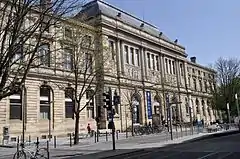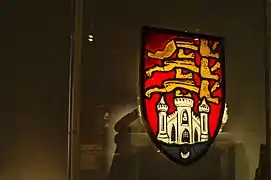Musée d'Aquitaine
The Museum of Aquitaine (French: Musée d'Aquitaine) is a collection of objects and documents from the history of Bordeaux and Aquitaine.
 | |
 Location within France | |
| Established | 1963 |
|---|---|
| Location | 20 cours Pasteur 33000 Bordeaux France |
| Coordinates | 44.83564°N 0.57497°W |
| Visitors | 111,919 (2003)88,738 (2004)99,880 (2005)101,897 (2006)93,661 (2007)[1] |
| Website | Official site |
Location
In the center of Bordeaux, close to Tour Pey-Berland and St. Andrew's Cathedral, the museum is accessible by line B of the tramway de Bordeaux from station Musée d'Aquitaine.
Collections
The different collections include more than 70,000 pieces. They trace the history of Bordeaux and Aquitaine from Prehistory to today. 5,000 pieces of art from Africa and Oceania also testify to the harbor history of the city.

The museum has permanent collections and temporary exhibitions. The permanent collections are on two floors. On the ground floor are pieces on Prehistory, Protohistory, the Roman Epoch, the Middle Ages and the Modern Era. At level 1, there are eighteenth century pieces (Atlantic trade and slavery), world cultures, nineteenth and twentieth centuries (Bordeaux port-e-du monde, 1800-1939).
In 2009, the Aquitaine Museum opened new permanent rooms dedicated to the role of Bordeaux in the slave trade.
Rooms devoted to the nineteenth were reopened in February 2014.
Notable Pieces[2]
- The Venus of Laussel
- The Gallic Gold torque
- The cenotaph of Michel de Montaigne
- Bernini, Bust of Cardinal Escoubleau de Sourdis
- Bronze Statue of Hercules
References


.jpg.webp)

.jpg.webp)
